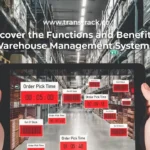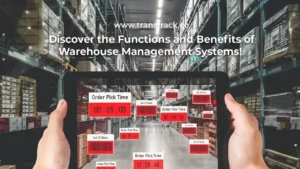What is Lead Time? Find Out the Definition, Types, and Ways to Shorten It
Posted on November 20, 2023 by Nur Wachda Mihmidati

Do you know what lead time is? In the business world, this term is one of the most important concepts. Whether you’re a business owner, a supply chain manager, or even a frequent customer. Understanding what lead time is and how to manage it can provide significant benefits.
To help you understand how the concept of time works, TransTRACK will explain it in detail in this article. We will discuss starting from the definition of this concept of time, types, influencing factors, and ways to shorten it.
What is Lead Time?
Lead time is the period of time required to complete a process or project from start to finish. In a business context, this time concept refers to the time it takes to manufacture or procure products from suppliers and deliver them to customers. In other words, this time concept is the time between when a customer places an order to when they receive the ordered product or service.
Types of Lead Time
There are several types of this time concept that can be encountered in business operations. Understanding the differences between these types is important for managing more efficient supply chains and production processes. Here are some common types of this timing concept:
Production Lead Time
Production lead time is the time it takes to produce a product from raw materials or semi-finished materials. It includes all steps in the production process, from concept and planning to delivery of the finished product.
The concept of production time plays an important role in ensuring sufficient product inventory and meeting customer demand. Good planning in this regard can improve production time efficiency and prevent delivery delays.
Ordering Lead Time
This type of lead time is probably the one you encounter most often. This ordering lead time concept is the time it takes to process a customer’s order until the order is received. It includes order processing, selection of goods from the warehouse, and preparation for shipment.
Understanding the concept of order timing helps in organizing the customer order process more efficiently. In an e-commerce business, this can affect the time between order and delivery.
Delivery Lead Time
Next there is the delivery lead time, which is the time it takes to send the product from the supplier to the customer. It includes the time required for order processing, packaging, shipping, and receipt of goods by the customer.
This delivery time concept is a key factor in measuring on-time delivery. Optimizing this time concept can help increase customer satisfaction and improve the company’s reputation.
Procurement Lead Time
A type of procurement lead time is the time required to obtain raw materials or goods from suppliers. This time concept can include the process of ordering, production, shipping, and receiving goods.
In industries that depend on specific raw materials, such as FMCG with fast production and turnaround times, managing the concept of procurement timing is important to maintain stock availability.
Factors Affecting Lead Time
A number of factors can affect this concept of time in a business. Understanding these factors helps in managing this concept of time more effectively. Some of the main factors that affect this concept of time include:
Product Complexity
More complex products usually require more time in the production process. This includes products with many components or special specification requests. The number of stages that must be passed makes this time concept longer.
Raw Material Availability
If the necessary raw materials are not available in a timely manner, production time concepts can be disrupted. Proper inventory and good supply chain management can help reduce these concept time delays.
Process Efficiency
A more efficient production process can reduce the concept of production time. This includes the use of advanced technology, employee training, and process optimization. The more efficient the process, the better the lead time.
Delivery from Supplier
Delays in deliveries from suppliers can extend the delivery time concept. Choosing a supplier that is reliable and has a good delivery record is important. So, make sure you don’t choose the wrong supplier.
How to Shorten Lead Time
Shortening this time concept can provide a competitive advantage and increase customer satisfaction. Here are some ways this concept of shortening time can be applied in your business:
Process Automation
Automating repetitive and time-consuming tasks can speed up production and order processing. Try to implement software and technologies that can automate tasks to speed up this time-concept process.
Efficient Supply Chain Management
Improving supply chain management, including reliable supplier selection and careful inventory management, can help reduce this time concept. Consider options such as JIT (Just-in-Time) to reduce inventory and shorten this concept of delivery time.
Employee Training
Provide appropriate training to improve employee skills and knowledge. Well-trained employees tend to be more efficient in their tasks, which can ultimately shorten this time concept.
Route and Logistics Optimization
In businesses that involve shipping products, it is important to optimize delivery routes. Use technology such as Fleet Management System (FMS) to plan more efficient routes and avoid traffic jams, so this time concept can be shortened.
Lead Time Formula
This time concept formula is useful for measuring and understanding this time concept more deeply. The basic formula for calculating lead time is:
Lead Time = Production Lead Time + Ordering Lead Time + Delivery Lead Time
This formula will give you an idea of how long it will take to deliver the product to the customer once the order is placed.
This concept of time is an important element in business management, especially in optimizing supply chains and customer satisfaction. Understanding how this concept of time, its types, factors that affect it, and ways to shorten it is an important step in managing business operations more efficiently.
In an increasingly competitive business era, efficient management of time concepts is key to winning customer trust and achieving competitive advantage. One of the effective ways to optimize this time concept is by utilizing TransTRACK’s Fleet Management System (FMS) technology. Implementing FMS is a smart move to optimize the time concept in your business. Fleet Management System, is a technology solution designed specifically for managing business vehicle fleets. FMS provides a variety of features and functions that include real-time location tracking, fuel usage monitoring, vehicle maintenance management, and route optimization to shorten deliveries. Contact TransTRACK now and request a free demo!
Recent Post
Topic :
 Bahasa Indonesia
Bahasa Indonesia









